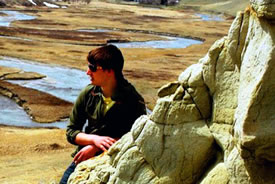Who will lead us next? Investing in the next generation of NCC leaders

Sandstone Ranch, AB (Photo by NCC)
I was feeling pretty nervous. About 25 Nature Conservancy of Canada (NCC) staff members from across the country were starting to take their seats for the first leadership development training session that NCC had ever organised. Sure, we’ve had lots of training courses in the past, but this was the first one to be focussed on leadership, rather than more technical training. Would the team embrace this chance, would it meet our needs and was it a good use of our donors' funds? Our entire executive group was fully supportive of this venture, but I was feeling an especial responsibility for it and was very conscious of how much it was costing.
It had all started when I attended a course run by the Ivey School of Business and sponsored by KPMG. This was a pilot course offering highly professional leadership development training to a handpicked group of Canadian not-for-profit senior executives.
Separately, at NCC, we were talking about how our existing executive/leadership team were getting older, and that we should be thinking about their eventual replacements. We’d determined that the best position to be in would be to have a choice of a number of great internal and external candidates. But to be able to do that, we would need to offer the appropriate training and development to our promising internal "potential future leaders" — what we called our "emerging leaders group." The question was, how to do that within a budget that seemed reasonable for a not-for-profit, while keeping the highly professional input provided by the team at Ivey?
After a lot of deliberation, we worked out a way; and kudos to Ivey for working with us through this process, being flexible about timing and greatly discounting their fees. The result was a two-part session totalling four days of intensive leadership study and development. This was a chance for our senior leaders and our younger probable future leaders to come together to learn, to share experiences and to have a solid foundation to go away and start working on their leadership style and activities. For many of our staff members this was the first time they had been exposed to case study-based training , led by a renowned professor from one of Canada’s foremost business schools.
Was it a success? The feedback from attendees was a resounding "yes." The program perfectly complemented the coaching and mentoring opportunities we were working on to develop for our future leaders. It also gave us time to think about the world, and our organisation, in a different way. We went away energised and committed to keep the learning process going.
That last sentence is the really important part. Our staff are committed to using this experience as a springboard for development and to continue the conversations started during the classroom part of the training. Corporately, we are exploring more formal ways to expand on this program.
Leadership and good management are as vital in a not-for-profit organisation as in any for-profit. Unless we give our staff the tools and the confidence to plan for the future and to execute on those plans, we will not be able to fulfill our mission. As an investment in our human capital, it will help the investments we plan to make in our conservation capital. Our staff members, and donors, deserve to have a professional, aligned and effective leadership capability at all levels of our organisation, so that we can achieve our long-term goals.


